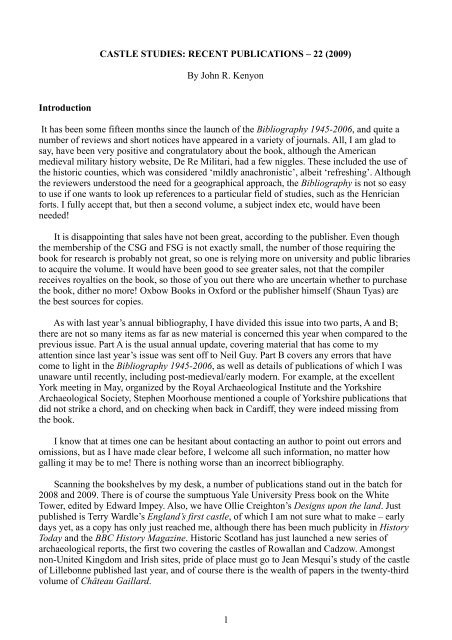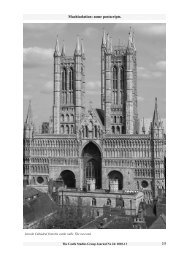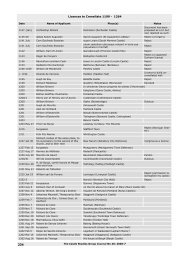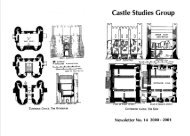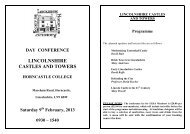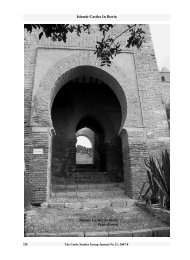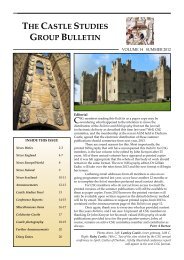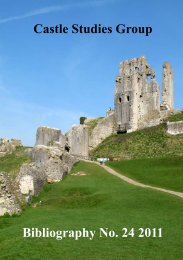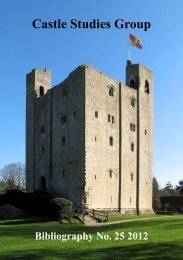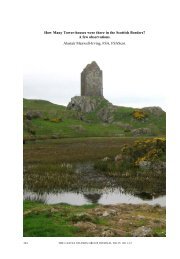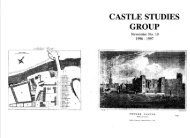Castle Studies Group Bibliography No. 22 2009
Castle Studies Group Bibliography No. 22 2009
Castle Studies Group Bibliography No. 22 2009
You also want an ePaper? Increase the reach of your titles
YUMPU automatically turns print PDFs into web optimized ePapers that Google loves.
CASTLE STUDIES: RECENT PUBLICATIONS – <strong>22</strong> (<strong>2009</strong>)By John R. KenyonIntroductionIt has been some fifteen months since the launch of the <strong>Bibliography</strong> 1945-2006, and quite anumber of reviews and short notices have appeared in a variety of journals. All, I am glad tosay, have been very positive and congratulatory about the book, although the Americanmedieval military history website, De Re Militari, had a few niggles. These included the use ofthe historic counties, which was considered ‘mildly anachronistic’, albeit ‘refreshing’. Althoughthe reviewers understood the need for a geographical approach, the <strong>Bibliography</strong> is not so easyto use if one wants to look up references to a particular field of studies, such as the Henricianforts. I fully accept that, but then a second volume, a subject index etc, would have beenneeded!It is disappointing that sales have not been great, according to the publisher. Even thoughthe membership of the CSG and FSG is not exactly small, the number of those requiring thebook for research is probably not great, so one is relying more on university and public librariesto acquire the volume. It would have been good to see greater sales, not that the compilerreceives royalties on the book, so those of you out there who are uncertain whether to purchasethe book, dither no more! Oxbow Books in Oxford or the publisher himself (Shaun Tyas) arethe best sources for copies.As with last year’s annual bibliography, I have divided this issue into two parts, A and B;there are not so many items as far as new material is concerned this year when compared to theprevious issue. Part A is the usual annual update, covering material that has come to myattention since last year’s issue was sent off to Neil Guy. Part B covers any errors that havecome to light in the <strong>Bibliography</strong> 1945-2006, as well as details of publications of which I wasunaware until recently, including post-medieval/early modern. For example, at the excellentYork meeting in May, organized by the Royal Archaeological Institute and the YorkshireArchaeological Society, Stephen Moorhouse mentioned a couple of Yorkshire publications thatdid not strike a chord, and on checking when back in Cardiff, they were indeed missing fromthe book.I know that at times one can be hesitant about contacting an author to point out errors andomissions, but as I have made clear before, I welcome all such information, no matter howgalling it may be to me! There is nothing worse than an incorrect bibliography.Scanning the bookshelves by my desk, a number of publications stand out in the batch for2008 and <strong>2009</strong>. There is of course the sumptuous Yale University Press book on the WhiteTower, edited by Edward Impey. Also, we have Ollie Creighton’s Designs upon the land. Justpublished is Terry Wardle’s England’s first castle, of which I am not sure what to make – earlydays yet, as a copy has only just reached me, although there has been much publicity in HistoryToday and the BBC History Magazine. Historic Scotland has just launched a new series ofarchaeological reports, the first two covering the castles of Rowallan and Cadzow. Amongstnon-United Kingdom and Irish sites, pride of place must go to Jean Mesqui’s study of the castleof Lillebonne published last year, and of course there is the wealth of papers in the twenty-thirdvolume of Château Gaillard.1


